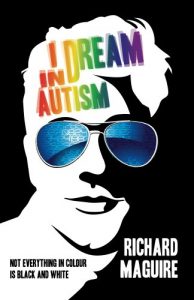I am autistic. See it my way.
I view your normality with interest and have grown up wanting to be you. I am now in my fifth decade and wouldn't swap places with you for one minute. I am fine – just as I am.
Are you sitting uncomfortably, then I'll begin...
Most people can learn the mysteries of life from other people. They decide the rules, communicate, interpret and fit in. Autistic people, like me, are wired differently. We perceive things internally and literally – experiencing the world with hyper-aware senses (and people with trepidation).
It’s not easy for a non-autistic person to grasp the behaviours of an ‘Aspie’ yet we are expected to function in a certain way for them. Our existence is lived as it is from behind a pane of glass… beyond touch and connection. An enigma. Connection with this life hurts. We were designed to live by different rules. So, we do need some type of rulebook to get through each day.
I Dream In Autism is a collection of writings based on my own life journey and decades of working with autistic people. People have a lot of expectations of me and often don’t think my autism is severe. They are visibly surprised when I disclose my condition. However, if I behave according to my autistic nature, they get cross and sometimes verbally aggressive. That’s a lot of pressure to endure which makes my life harder.
Mild-autism is someone else’s judgement – they see me acting ‘normal’ and believe it to be a reliable indication of my true self. I maintain an act as much as possible because life has taught me that things get very bad if I don’t (this is a common autistic way of living).
My autobiography is woven with insight, observations and ways for autistic or learning disabled service users and families living with an autistic sufferer to see inside the syndrome from an autistic point of view. I wanted my work to be a useful tool read by ‘normal’ people as an informed way of how to interact with special individuals.
Read this book forwards, backwards or in bite-sized chunks to see through the eyes of an ‘Aspie’ as we are beginning to be affectionately referred to (and I like this). Understand my obsessive need to repeat intricate details through stories of being bullied, lost, loved and misunderstood.
It will change your life.
I view your normality with interest and have grown up wanting to be you. I am now in my fifth decade and wouldn't swap places with you for one minute. I am fine – just as I am.
Are you sitting uncomfortably, then I'll begin...
Most people can learn the mysteries of life from other people. They decide the rules, communicate, interpret and fit in. Autistic people, like me, are wired differently. We perceive things internally and literally – experiencing the world with hyper-aware senses (and people with trepidation).
It’s not easy for a non-autistic person to grasp the behaviours of an ‘Aspie’ yet we are expected to function in a certain way for them. Our existence is lived as it is from behind a pane of glass… beyond touch and connection. An enigma. Connection with this life hurts. We were designed to live by different rules. So, we do need some type of rulebook to get through each day.
I Dream In Autism is a collection of writings based on my own life journey and decades of working with autistic people. People have a lot of expectations of me and often don’t think my autism is severe. They are visibly surprised when I disclose my condition. However, if I behave according to my autistic nature, they get cross and sometimes verbally aggressive. That’s a lot of pressure to endure which makes my life harder.
Mild-autism is someone else’s judgement – they see me acting ‘normal’ and believe it to be a reliable indication of my true self. I maintain an act as much as possible because life has taught me that things get very bad if I don’t (this is a common autistic way of living).
My autobiography is woven with insight, observations and ways for autistic or learning disabled service users and families living with an autistic sufferer to see inside the syndrome from an autistic point of view. I wanted my work to be a useful tool read by ‘normal’ people as an informed way of how to interact with special individuals.
Read this book forwards, backwards or in bite-sized chunks to see through the eyes of an ‘Aspie’ as we are beginning to be affectionately referred to (and I like this). Understand my obsessive need to repeat intricate details through stories of being bullied, lost, loved and misunderstood.
It will change your life.






